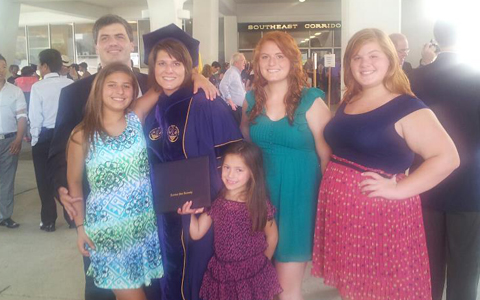 In the mystery of his death and resurrection, God has revealed in its fullness the Love that saves and calls us to conversion of life through the forgiveness of sins (cf. Acts 5:31). For Saint Paul, this Love ushers us into a new life: “We were buried … with him by baptism into death, so that as Christ was raised from the dead by the glory of the Father, we too might walk in newness of life” (Rom 6:4). Through faith, this new life shapes the whole of human existence according to the radical new reality of the resurrection. To the extent that he freely cooperates, man’s thoughts and affections, mentality and conduct are slowly purified and transformed, on a journey that is never completely finished in this life. (Porta Fidei 6)
In the mystery of his death and resurrection, God has revealed in its fullness the Love that saves and calls us to conversion of life through the forgiveness of sins (cf. Acts 5:31). For Saint Paul, this Love ushers us into a new life: “We were buried … with him by baptism into death, so that as Christ was raised from the dead by the glory of the Father, we too might walk in newness of life” (Rom 6:4). Through faith, this new life shapes the whole of human existence according to the radical new reality of the resurrection. To the extent that he freely cooperates, man’s thoughts and affections, mentality and conduct are slowly purified and transformed, on a journey that is never completely finished in this life. (Porta Fidei 6)
In part 1, I identified what seem to be essential elements to the New Evangelization. The list is certainly not comprehensive. However, we can, with certainty identify the New Evangelization with a re-proposal of the faith, which can be nothing other than the re-proposal of “Jesus, his Gospel and his way. Christian life is defined by an encounter with Jesus. When Jesus first came among us, he offered a whole new way of living” (Cardinal Wuerl).
The present post aims to identify what the New Evangelization is not. This is a rather arduous task, then, because everything that is not the proposal of Christ could tend toward this category. Still, it will be helpful to highlight several common “reductions.”
What the New Evangelization is Not
- An opportunity for the Church to wall herself in (i.e. a complacent re-proposal of her message to her own, and the disregard for those outside the fold). Pope Francis has been rather clear on this. The New Evangelization serves to re-propose Christianity within traditionally Christian countries, for the sake of the Church’s universal missionary call.
- “Hyper-efficiency.” In a recent statement to lay movements, Pope Francis said, “The devil deceives us and we risk falling into the trap of hyper-efficiency. Preaching Jesus is one thing; attaining goals, being efficient is another. No, efficiency is a different value. Basically the value of the Church is living by the Gospel and witnessing to our faith. The Church is the salt of the earth, she is the light of the world.” We must take care to avoid adopting any sort of utilitarian mindset. An over-emphasis on hyper-efficiency always results in forgetting the person in front of you, the person both in need of Christ, and who is Christ right now. This leads into the next temptation.
- Impatience. There is a tremendous danger in looking only for the immediate gratification of attracting large numbers of people. Ratzinger took up this topic in his 2000 address to Catechists. In response, he proposes the structure of the New Evangelization, or what might be considered a guiding image for all evangelization: the image of the mustard seed. He says:
“The Kingdom of God always starts anew under this sign. New evangelization cannot mean: immediately attracting the large masses that have distanced themselves from the Church by using new and more refined methods. No—this is not what new evangelization promises. New evangelization means: never being satisfied with the fact that from the grain of mustard seed, the great tree of the Universal Church grew; never thinking that the fact that different birds may find place among its branches can suffice—rather, it means to dare, once again and with the humility of the small grain, to leave up to God the when and how it will grow” (Mark 4:26-29).
- New Strategy, Program, or Process. This reduction is perhaps at the heart of the rest – reducing the New Evangelization to a use of new technology, or finding a scheme that will make the Gospel relevant again. Our strategies, programs, and processes, especially as we’ve become bogged down with them over the last 40 years, have become vapid. They are sterile and do not provide a satisfying answer to the question “how am I to live?” A question that only a person can answer. It is terribly ironic (and telling) that we must create programs to put Christ back at their core. What have we been doing in ministry if it isn’t Christ? If “program-driven” ministry forgot the Person of Christ in the first place, how can He successfully be programmed back in. This could be likened to trying to revive the dead man with the same poison that killed him. I believe this is what Msgr. Luigi Giussani was getting at in an interview shortly before his death, when he said, “The Church began to fail mankind, as I see it, as we see it, because she forgot who Christ was, she did not rely on… she was ashamed of Christ, of saying who Christ is.”
The “Program” and False Hope
At the heart of all of these temptations or reductions of the New Evangelization is that ever-old, ever-new human problem of pride and autonomy. I recall a certain event in a garden, with the eating of fruit from a forbidden tree. Adam and Eve forgot who God was and preferred their own ways to His; they preferred a human means to happiness as opposed to God’s means. This is really a false hope, a turning toward man and his resources, instead of entering into communion with the Source. We are not immune to the same temptation, in fact, man’s self-reliance dominates the landscape today.
In ministry, too often we have tried to build up the community through purely human means. The hope is always the same – find a magic bullet, a facile response to whatever problem we perceive. And while some fruit comes about, our semi-Pelagianism has really produced an incredible amount of barren trees (the statistics are telling). We fool ourselves into thinking that if only our projects are founded upon Christ, that if His love compels us, then we can expect great things. But here we risk using Christ for our own gain. We expect something out of our projects and processes, instead of hoping in Christ alone.
The real temptation lies in expectancy.
Does my faith lead me to “truly expect everything from the fact of Christ,” or to decide to expect something other, “ultimately making Him a starting point and a support for our projects and programs” (Giussani – Talk given on Feb. 27, 1972)? The New Evangelization must be faith in Christ, hope in Christ, and love of and in Christ, or else we risk using him for our programs in which seek our fulfillment. We cannot substitute a program for real conversion to Christ. We cannot mistake the means for the end.
To be sure, modern methods of communicating the Gospel are valuable. We cannot escape modernity and its methods of communication. But its means cannot confine the Gospel to a designated realm, or a mere fraction of one’s life. As Cardinal Ratzinger said, “All reasonable and morally acceptable methods should be studied – to use these possibilities of communication is a duty. But words and the whole art of communication cannot reach the human person to such depths as the Gospel must reach…” Pope Francis recently made a similar remark: “We might think we should work out programs of evangelization carefully, thinking of strategies and making plans, but these are only tools, small tools. What matters is Jesus and letting ourselves be led by him.”
The “New” Evangelist – An attempt at a synthesis:
In light of all that has been said to this point in identifying both the centrality of the Person of Christ and common pitfalls or false hopes of the New Evangelization, is it possible to identify a disposition suitable for the evangelist (remember that all Christians are called to evangelize as part of their baptismal mission)? What must the evangelist’s “expectancy” in Christ look like? Here, I would like to provide three considerations, quoting from Pope Benedict:
- Prayer and Self-Sacrifice. “Jesus had to acquire the disciples from God. The same is always true. We ourselves cannot gather men. We must acquire them by God for God. All methods are empty without the foundation of prayer. The word of the announcement must always be drenched in an intense life of prayer….We must add another step. Jesus preached by day, by night he prayed — this is not all. His entire life was — as demonstrated in a beautiful way by the Gospel according to St. Luke — a path toward the cross, ascension toward Jerusalem. Jesus did not redeem the world with beautiful words but with his suffering and his death. His Passion is the inexhaustible source of life for the world; the Passion gives power to his words” (Cardinal Ratzinger’s Address to Catechists in 2000).
- Confession or Witness. “In the essence of the “confessio” of our Creed, an openness to passion, suffering, indeed, giving up life is implied. And this guarantees credibility: the “confessio” is not just something that can be abandoned; the “confessio” implies the willingness to give up my life, to accept the passion. This is also truly the verification of the “confessio”. It can be seen that for us “confessio” is not a word, it is more than pain, it is more than death. For the “confessio” it is really worth suffering, it is worth suffering up to death. Whoever makes this “confessio” shows in this way that what he confesses is more than life: it is life itself, the treasure, the precious and infinite pearl” (Benedict XVI – Oct. 8, 2012).
- Charity. “Confessio” is not an abstract thing, it is “caritas”, it is love. Only in this way is it really the reflection of divine truth, which as truth is also, inseparably, love. In very powerful words the text describes this love: it is ardour, it is flame, it ignites others. There is a passion of ours that must grow from faith, that must be transformed into the fire of charity” (Benedict XVI – Oct. 8, 2012).
Here, in these three points, we see the real impact of this encounter with Christ – an impact that does not mistake means for an end, but turns in prayer to the heart of Christ. Only here, only in expecting everything from faith in Christ, can one hope to live out the Christian call of charity, which is not without suffering unto death. The encounter with Christ, then, becomes a participation in a journey, in His journey, and certainly not one that is accomplished in this life. Yet, “Through faith, this new life shapes the whole of human existence according to the radical new reality of the resurrection” (Porta Fidei 6).
In the end, we must remember that we don’t produce the Church. Successful evangelization is not the result of a human work or process or project. Evangelization roots itself in a participation in the life and mission of the Redeemer, the action of the Holy Spirit, and the love of the Father. This is what Pope Benedict reminded those gathered at the recent Synod:
“The first word, the true initiative, the true activity comes from God and only by inserting ourselves in to the divine initiative, only by begging this divine initiative, will we too be able to become – with him and in him – evangelizers. God is always the beginning, and always it is only he who can make Pentecost, who can create the Church, who can show the reality of his being with us. But, on the other hand, however, this God, who is always the beginning, also wants to involve our activity, so that the activities are theandric, so to speak, made by God, but with our involvement and implying our being, all our activity. So when we are carrying out the new evangelization it is always cooperation with God, it is in the togetherness with God, it is based on prayer and his real presence” (Pope Benedict XVI – Oct. 8, 2012).
If you liked this article, please share it with your friends and family using the Share and Recommend buttons below and via email. We value your comments and encourage you to leave your thoughts below. Thank you! – The Editors













